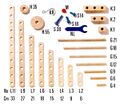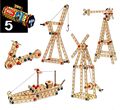Category:Wooden toys made by the Lego company
1930s: The Lego name, as rubber-stamped onto the side doors of a wooden fire engine in white paint, circa 1934-1939 [image info]
~1939-: The black, gold and red decal used on the Lego company's wooden toys from around 1939 onward. The logo appears to show the golden LEGO name proudly upright in a flat opened rectangular box, backed by the box lid. Assuming that the box is a toybox, the logo would seem to say "LEGO means toy" [image info]
1959-1960: The separate "Bilofix" brand started being used on all Lego company wooden toys from 1959. After a fire in 1960, the company decided to stop wooden toy manufacture. [image info]
Ole Kirk Christiansen started out as a carpenter, wanting to make high-quality furniture. This dream took a battering during the 1920s and the international consequences of the Great Depression – when money was tight, people tended to "make do" and not go out and buy new expensive furniture. With the further blow of the death of his wife in 1932, things looked bleak, and it was suggested to Ole that he try something different.
~1932: The yo-yo
The "yo-yo" craze had started in 1929 in America and was spreading world-wide, with yo-yos starting to be manufactured in Sweden in 1932. Why not make wooden toys? Toys were simple, easy to make, didn't need much wood, didn't need to be tailored to an individual customer's needs, could be made and stockpiled when free time was available ... and the cheerful subject might help Ole to stop thinking about the past. Also, toys were more recession-proof than furniture – when money was short, parents might cut back on their spending on themselves, but they would be reluctant to make their children go without.
Ole started his new wooden toy business in 1932, making a range of toys, along with small household items such as ladders and ironing-boards. When the yo-yo "bubble" burst, leaving Ole with stocks of unsold yo-yos, he cut them in half and turned them into wooden wheels for toy trucks.
"Only the best is good enough"
Ole quickly realised that the new toy business was not just a way to clear his debts before getting back into the furniture-making business: to do toymaking properly, one had to commit to it. He needed to put furniture-making behind him and dedicate himself to becoming a full-time professional toymaker. But if he was going to be making toys from now on, they would be proper toys, properly finished, with no corners cut ... they would not "only" be toys, they would be quality products that he would be proud to declare were his own, and not something that he'd feel the need to apologise for, or consider to be a step down from his first love, cabinetmaking.
1934: "LEGO"
In 1934, Ole decided to properly brand his new range of toys, and held a competition amongst the workforce to come up with a new name. Front-runners were "Legio" (suggesting "Many") and "Lego" (suggesting the Danish phrase "leg godt", or "play well"). It may not have been coincidence that both names included the letters of Ole's first name, and Ole selected the shorter one as the winner, awarding himself the prize for having thought of it (!).
Investment
Ole's insistence on doing things the expensive way and not skimping on finishes sometimes bewildered his family, but in the end, it paid off. At one point, the company spent an awful lot of money on an industrial milling machine. With the new machine, a truck's flatbed goods area with its four walls could be simply and quickly milled out of a single block of wood, with no joints to glue or nail. The top part of a lorry cab needn't be made out of a roof, back wall, and two angled struts: again, it could be milled out of a single solid block. The resulting "machined" wooden toys were more sturdy, faster to make, and had a distinctive "look" that smaller toymakers with less advanced equipment found it difficult to reproduce.
Plastics
When the investment in the milling machine seemed to be paying off, Ole then took the next step, deciding that some of the parts on the wooden toys were still too fiddly, and that the next logical step was to invest in an injection moulding machine and start making some of the components in plastic.
This resulted in a set of "hybrid" toys, with wood providing a study stylised body for a lorry, but the cab being made of plastic in order to properly replicate the specific recognisable curves of the Chevrolet lorries that were being imported into Denmark.
1959: "Bilofix"
The purchase of Denmark's first injection-moulding machine had brought with it the option of making new sorts of all-plastic toys, such as the clip-together plastic bricks that the Lego company were now selling, and which seemed to be taking over more and more of the company's output.
With "LEGO" becoming increasingly synonymous with the plastic bricks – especially in foreign markets, where the wooden toys weren't available, and the "Lego" name was only familiar through the bricks, Lego decided in 1959 to rebrand all their wooden toys under a separate name: Bilofix.
In 1960, another major fire left Lego in the position of having to rebuild again, and they took the decision to only reequip for making the plastic bricks, and to stop making wooden toys altogetehr ... a level of specialisation that some may have felt alarming, and perhaps even foolhardy. Two family members took on the "Bilofix" brand, and started making and selling the "Bilofix Engineer" wooden construction sets as a separate company.
From this point onwards Lego's identity was that it was the company that made Lego bricks, and as the brand moved from strength to strength internationally, many of its customers could be forgiven for assuming that the company had never made anything else.
External links
Pages in category ‘Wooden toys made by the Lego company’
The following 17 pages are in this category, out of 17 total.
F
Media in category ‘Wooden toys made by the Lego company’
The following 12 files are in this category, out of 12 total.
- Bilofix Chest (Bilofix ~1960s).jpg 2,057 × 1,745; 401 KB
- BILOfix Component Parts (BILOfix ~1960s).jpg 1,200 × 1,038; 167 KB
- BILOfix leaflet (BILOfix 1960s).jpg 1,200 × 1,069; 204 KB
- BILOfix logo.jpg 1,890 × 723; 72 KB
- BILOfix models, examples (Bilofix ~1960s).jpg 3,000 × 1,357; 520 KB
- BILOfix Set 3, examples (BILOfix ~1960s).jpg 1,800 × 1,601; 321 KB
- BILOfix Set 5, examples (BILOfix ~1960s).jpg 1,800 × 1,649; 379 KB
- BILOfix Set 5, packaging (BILOfix ~1960s).jpg 1,211 × 1,069; 145 KB
- BILOfix Set 7, examples (BILOfix ~1960s).jpg 1,800 × 1,606; 385 KB
- BILOfix The Toy That Teaches (BILOfix ~1960s).jpg 1,200 × 1,067; 209 KB
- Lego logo, stamped on a wooden toy (1930s).jpg 648 × 331; 57 KB
- Lego wooden toys decal (~1939-).jpg 2,355 × 987; 249 KB
















